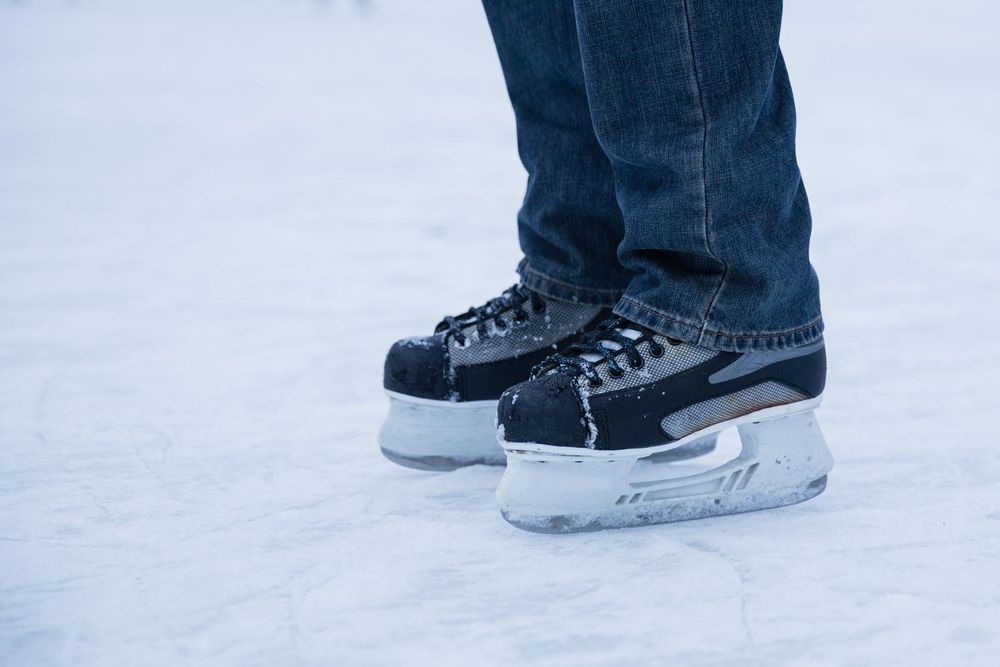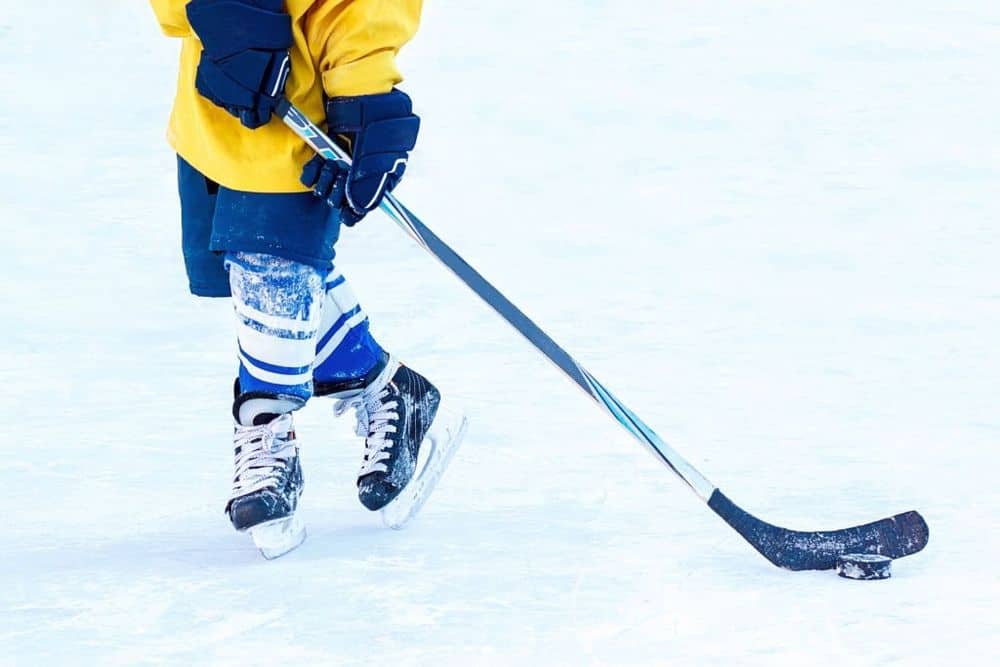Did you know that choosing the right socks to wear with your hockey skates can greatly impact your performance on the ice?
In this article, we will explore the importance of proper sock selection, the different types of hockey socks available, and the benefits they provide in terms of protection, moisture control, and overall foot health.
Whether you’re a seasoned player or just starting out, understanding the role of socks in your hockey gear is crucial for achieving optimal comfort and performance.
Importance of Wearing Socks With Hockey Skates
Wearing socks with hockey skates is essential for optimal comfort, protection, and hygiene. Going sockless in hockey skates may seem tempting, but it comes with its own set of pros and cons.
While some players advocate for maximum contact between their feet and the skate, going without socks can lead to increased moisture inside the skates. This can result in damp or wet skates, unpleasant odors, and a higher likelihood of blisters.
On the other hand, wearing socks provides increased protection and cushioning, warmth and dryness, and prevents rubbing while allowing space for feet to breathe. It is important to choose the right fit and material for your socks, such as moisture-absorbing materials like wool, nylon, or acrylic, to ensure overall comfort and performance on the ice.
Different Types of Hockey Socks
There are various types of hockey socks available for players to choose from.
While some players debate on wearing no socks for maximum contact with the skate, others prefer the simplicity of ankle socks.
Thick socks offer increased protection and cushioning, while wool hiking socks are a popular choice for warmth and dryness.
Thin socks prevent rubbing and provide space for feet to breathe.
Taller socks provide more leg protection against skate blades and pucks, and the extra material keeps legs warmer.
Cut-proof skate socks offer even greater protection.
It is recommended to choose moisture-absorbing materials like wool, nylon, and acrylic to keep feet dry and comfortable.
Ultimately, personal preference plays a role in choosing the right fit and type of hockey socks.
Thick Socks for Increased Protection
One option for increased protection when wearing hockey skates is to choose thick socks. The sock thickness debate has been a topic of discussion among hockey players for years. Here are four benefits of wearing thick socks with your skates:
- Enhanced cushioning: Thick socks provide an extra layer of padding between your feet and the skate, offering increased comfort and shock absorption during intense gameplay.
- Added insulation: When playing in cold rinks, thick socks can help keep your feet warm by trapping heat and preventing cold air from seeping in.
- Reduced friction: The extra material in thick socks helps to minimize rubbing and friction between your feet and the skate, reducing the risk of developing blisters.
- Improved moisture management: Thick socks made from moisture-wicking materials like wool or synthetic fibers can effectively absorb sweat and keep your feet dry, preventing the build-up of moisture inside the skate.
Wool Hiking Socks for Warmth and Dryness
Continuing the discussion on sock options for hockey skates, another suitable choice for warmth and dryness is wool hiking socks. Wool hiking socks provide excellent insulation and moisture-wicking properties, making them ideal for keeping your feet dry and comfortable during intense hockey games. Compared to synthetic socks, wool hiking socks offer superior warmth and insulation, as wool is a natural insulator that retains heat even when wet. Additionally, wool has excellent moisture-wicking abilities, pulling sweat away from your skin and allowing it to evaporate, keeping your feet dry and reducing the chance of blisters. The following table highlights the benefits of wool hiking socks compared to synthetic socks for warmth and dryness:
| Wool Hiking Socks | Synthetic Socks |
|---|---|
| Superior warmth and insulation | Lesser warmth and insulation |
| Excellent moisture-wicking abilities | Limited moisture-wicking abilities |
| Reduces the chance of blisters | Higher chance of blisters |
| Natural and breathable | Synthetic and less breathable |
Thin Socks for Preventing Rubbing and Breathability
To address the issue of preventing rubbing and ensuring breathability, thin socks are a practical choice when wearing hockey skates. Here are four reasons why thin socks are beneficial for comfort and performance:
- Reduced friction: Thin socks minimize the likelihood of rubbing against the skin, reducing the risk of blisters and discomfort during play.
- Enhanced skate fit: Thick socks can take up more space inside the skate, potentially affecting the fit. Thin socks provide a closer fit, allowing for better control and responsiveness on the ice.
- Improved breathability: Thin socks allow for better air circulation, preventing excessive moisture buildup inside the skate. This helps to keep the feet dry and comfortable throughout the game.
- Lightweight feel: Thin socks provide a lighter feel, allowing players to move more freely on the ice without feeling weighed down.
No Socks for Maximum Contact With Skate (Debate)
The debate surrounding the practice of going sock-less in hockey skates centers on the pursuit of maximum contact between the foot and the skate blade. Some players argue that by eliminating the barrier of socks, they can achieve a more direct connection, enhancing their control and responsiveness on the ice. However, there are both benefits and drawbacks to consider.
| Benefits of wearing socks | Pros and cons of maximum contact with skate |
|---|---|
| Increased protection and cushioning | Enhanced control and responsiveness on the ice |
| Warmth and dryness | Potential for increased moisture inside the skates |
| Prevention of rubbing and space for feet to breathe | Damp or wet skates |
| Personal preference and finding the right fit | Unpleasant odors |
| Higher likelihood of blisters | |
| Lack of protection for feet |
While maximum contact with the skate blade may offer advantages in terms of control, it is important to weigh these benefits against the potential drawbacks, such as increased moisture, unpleasant odors, and a higher risk of blisters. Ultimately, the decision to go sock-less should be based on personal preference, comfort, and the individual player’s specific needs.
Trying on Different Socks for Personal Preference
When selecting socks to wear with hockey skates, players can experiment with different options to find the best fit for their personal preference. Trying different sock materials and styles can make a significant difference in comfort and performance on the ice.
Here are four factors to consider when trying on different socks:
- Moisture-wicking properties: Materials like wool, nylon, and acrylic are recommended for their ability to absorb moisture and keep feet dry and comfortable.
- Cushioning and protection: Thick socks offer increased cushioning and protection, while cut-proof skate socks provide even greater protection against injuries.
- Ankle socks: Opting for ankle socks is a simpler choice that offers less leg coverage. They are ideal for players who prefer a minimalist feel and maximum contact with the skate.
- Personal preference and fit: Finding the right fit is crucial for overall comfort and confidence on the ice. Players should consider their own preferences and try on different socks to determine what works best for them.
Taller Socks for Leg Protection
Continuing the discussion on sock options for hockey skates, taller socks provide enhanced leg protection against skate blades and pucks. When choosing the right length for hockey socks, it’s important to consider the pros and cons of taller socks for leg protection.
Taller socks offer additional coverage, extending beyond the top of the skate, which helps prevent cuts and bruises from skate blades. They also provide an extra layer of padding, reducing the impact of pucks or accidental contact. However, taller socks may feel bulkier and restrict movement slightly.
It’s a personal preference whether to opt for taller socks or shorter ones. Ultimately, the decision should be based on the player’s comfort, protection needs, and the fit of the socks within the skates.
Cut-Proof Skate Socks for Enhanced Safety
Taller socks provide enhanced leg protection against skate blades and pucks, but for even greater safety, cut-proof skate socks are a recommended option.
Here are some key points to consider regarding cut-proof skate socks vs. regular hockey socks:
- Enhanced safety: Cut-proof skate socks are specifically designed to protect against lacerations caused by skate blades. They feature cut-resistant materials that provide an extra layer of protection for the legs.
- Injury prevention: Cut-proof skate socks can significantly reduce the risk of serious injuries, such as deep cuts and tendon damage, by providing a barrier between the skate blades and the skin.
- Performance impact: While cut-proof skate socks offer superior safety, they can be slightly thicker and less breathable compared to regular hockey socks. Some players may experience a slight decrease in performance due to the added bulk and potential discomfort.
- Drawbacks: Cut-proof skate socks tend to be more expensive than regular hockey socks. Additionally, the extra layers of material may affect the fit of the skate and require adjustments to ensure proper comfort and performance.
Ankle Socks for Simplicity
One option for simplicity when wearing socks with hockey skates is to choose ankle socks. Ankle socks are shorter in length, typically reaching just above the ankle bone. They offer a minimalist approach to sock-wearing, providing a lightweight and breathable option for players.
The advantages of wearing ankle socks include convenience and ease of use. They are quick to put on and take off, making them a popular choice for players who prioritize simplicity. Additionally, ankle socks allow for increased mobility and flexibility, as they do not cover the entire calf or leg.
However, there are some disadvantages to consider when wearing ankle socks with hockey skates. Firstly, ankle socks provide less protection and cushioning compared to taller socks. This can lead to increased friction and the potential for blisters. Additionally, ankle socks offer minimal leg coverage, which may leave players more vulnerable to cuts from skate blades or pucks.
Ultimately, the decision to wear ankle socks with hockey skates depends on personal preference and the level of protection desired. Players should weigh the pros and cons before making a choice, ensuring their comfort and safety on the ice.
Moisture-Absorbing Materials and Choosing the Right Fit
To effectively address moisture concerns and ensure optimal comfort, it is essential to prioritize socks made with moisture-absorbing materials and a proper fit.
When choosing the right moisture-absorbing materials for hockey socks, consider options such as wool, nylon, and acrylic. These materials have moisture-wicking properties that keep feet dry and comfortable during intense gameplay.
Additionally, finding the perfect fit for hockey socks is crucial for overall comfort and confidence on the ice. Consider factors such as thickness and cushioning, material and moisture-wicking properties, length and leg protection, and personal preference when selecting the right fit.
Frequently Asked Questions
Can I Wear Regular Cotton Socks With Hockey Skates?
It is not recommended to wear regular cotton socks with hockey skates. Opting for moisture-absorbing materials like wool, nylon, or acrylic is advised for increased comfort, dryness, and prevention of odors and blisters.
Are There Any Socks Specifically Designed to Prevent Blisters?
Moisture-wicking socks with reinforced heel and toe areas are specifically designed to prevent blisters when wearing hockey skates. These socks help to keep feet dry, reduce friction, and provide added cushioning and protection.
What Are the Benefits of Wearing Ankle Socks With Hockey Skates?
The benefits of wearing ankle socks with hockey skates include improved comfort, breathability, and a closer fit to the skate. However, proper sock fit is crucial to ensure maximum protection, cushioning, and prevention of blisters.
How Do I Determine the Right Fit for Hockey Socks?
Determining the right fit for hockey socks involves considering personal preference and finding the appropriate sock material. Factors such as thickness, cushioning, moisture-wicking properties, and length for leg protection should be taken into account.
Are There Any Socks That Provide Extra Padding for the Ankle Area?
When considering socks for hockey skates, it is important to prioritize extra cushioning and moisture-wicking properties. These features provide increased protection and comfort for the ankle area, enhancing overall performance and reducing the risk of injury.
Conclusion
In conclusion, choosing the right socks to wear with hockey skates is crucial for optimal performance and foot health on the ice. Whether you prefer thick socks for increased protection, wool hiking socks for warmth and dryness, or thin socks for breathability, there are various options available to meet your needs.
Additionally, considering factors such as moisture control and the right fit will further enhance your comfort and overall experience on the rink. So, make sure to give proper attention to your sock selection for a successful and enjoyable hockey game.









